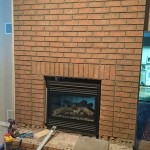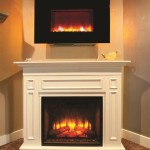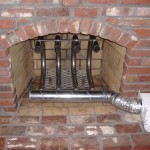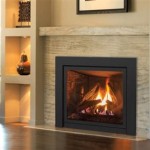How To Update Your Brick Fireplace: A Comprehensive Guide
A brick fireplace, while often a central and comforting feature in a home, can sometimes feel dated or clash with evolving interior design aesthetics. Updating a brick fireplace doesn't necessarily require a complete demolition and rebuild. There are numerous techniques, ranging from simple cosmetic changes to more involved structural alterations, that can revitalize its appearance and integrate it seamlessly into a modern living space. This article provides a detailed exploration of several methods to update a brick fireplace, outlining the necessary steps, tools, and considerations for each approach.
Cleaning and Preparation: The Foundation for Success
Regardless of the intended update method, a thorough cleaning of the brick is a crucial first step. Over time, brick can accumulate soot, dust, and even grease splatters, obscuring its natural color and texture. A clean surface ensures proper adhesion of any paints, stains, or other materials applied during the updating process. The cleaning process itself varies depending on the severity of the grime.
For light cleaning, a solution of warm water and mild dish soap, applied with a stiff-bristled brush, is often sufficient. The solution should be scrubbed into the brick surface, paying particular attention to crevices and mortar joints. After scrubbing, thoroughly rinse the brick with clean water to remove any soap residue. Allow the brick to dry completely before proceeding to the next step.
More stubborn stains and soot buildup might require a stronger cleaning agent. A commercial brick cleaner, available at most home improvement stores, can be effective. It is imperative to follow the manufacturer's instructions carefully when using these cleaners, as some can be harsh and potentially damage the brick if used improperly. Always test the cleaner on a small, inconspicuous area first to ensure it does not discolor or otherwise harm the brick. Protective gear, including gloves and eye protection, is strongly recommended when working with chemical cleaners.
For particularly difficult stains, consider using a poultice. A poultice is a paste made from an absorbent material, such as diatomaceous earth or baking soda, mixed with a cleaning agent. The poultice is applied to the stain, covered with plastic wrap, and allowed to sit for several hours or even overnight. The absorbent material draws the stain out of the brick. After removing the poultice, thoroughly rinse the area with clean water.
Once the brick is clean and dry, inspect the mortar joints for any cracks or damage. Repairing these imperfections is essential for both aesthetic and structural reasons. Cracks in the mortar can allow moisture to penetrate the brickwork, leading to further damage over time. Use a chisel and hammer to carefully remove any loose or crumbling mortar. Then, mix a batch of new mortar according to the manufacturer's instructions and apply it to the joints using a trowel. Smooth the mortar to match the existing joints. Allow the mortar to cure completely before proceeding with any further updates.
Painting Brick: A Transformation Through Color
Painting a brick fireplace is a relatively simple and cost-effective way to dramatically alter its appearance. It allows for complete color customization and can instantly modernize a dated fireplace. However, it is crucial to select the right type of paint and to properly prepare the surface for optimal results.
The most suitable type of paint for brick fireplaces is a masonry paint, specifically designed to adhere to porous surfaces like brick. These paints are typically breathable, allowing moisture to escape from the brickwork, preventing blistering and peeling. Latex acrylic paint is also a viable option, particularly for interior brick. Oil-based paints are generally not recommended for brick fireplaces as they can trap moisture and eventually lead to paint failure.
Before painting, apply a masonry primer to the clean, dry brick surface. The primer seals the brick, creating a uniform surface for the paint to adhere to. It also helps to prevent the paint from being absorbed into the porous brick, ensuring a consistent color and finish. Apply the primer according to the manufacturer's instructions, typically using a brush or roller. Allow the primer to dry completely before applying the paint.
When applying the paint, use a brush to work the paint into the crevices and mortar joints. A roller can be used to cover the flat surfaces of the brick. Apply two coats of paint, allowing each coat to dry completely before applying the next. This ensures even coverage and a durable finish. Consider using different sheens of paint to create different effects. A matte finish will provide a more subtle and understated look, while a semi-gloss or gloss finish will add a touch of sheen and highlight the brick's texture.
For those hesitant to commit to a solid color, consider whitewashing or German schmear techniques. Whitewashing involves diluting paint with water and applying it to the brick, allowing some of the original brick color to show through. This creates a softer, more textured look. German schmear involves applying a layer of mortar over the brick and then partially wiping it away, creating a rustic and distressed appearance.
Adding a Mantel: A Focal Point for Design
Installing a mantel above a brick fireplace can significantly enhance its visual appeal and create a focal point in the room. A mantel provides a surface for displaying decorative items, such as artwork, photos, and seasonal decorations. It also adds a sense of architectural interest and can complement the overall style of the room.
The selection of a mantel should be based on the size and style of the fireplace, as well as the overall aesthetic of the room. Mantels are available in a wide range of materials, including wood, stone, and metal. Consider the durability, maintenance requirements, and cost of each material when making your decision. A rustic wood mantel might be suitable for a farmhouse-style living room, while a sleek stone mantel might be a better fit for a modern space.
Before installing the mantel, determine the desired height. A general guideline is to position the mantel approximately 12 inches above the fireplace opening. However, this can vary depending on the size of the fireplace and the height of the ceiling. Use a level to ensure that the mantel is installed straight and even.
The installation method will depend on the type of mantel and the construction of the fireplace. In some cases, the mantel can be attached directly to the brickwork using screws and masonry anchors. In other cases, it may be necessary to install a support structure behind the brickwork to provide additional support. If you are unsure about the proper installation method, consult with a professional.
Once the mantel is installed, caulk any gaps between the mantel and the brickwork to create a seamless finish. Paint or stain the mantel to match the desired color and finish. Then, decorate the mantel with your favorite decorative items to complete the look.
Updating a brick fireplace requires careful planning and execution, but the results can be transformative. By following these guidelines and considering the specific characteristics of your fireplace and living space, it is possible to revitalize this central feature and create a more inviting and stylish home.

How To Update A Brick Fireplace Homemade Ginger

How To Paint A Brick Fireplace 1950 S House Update

16 Red Brick Fireplace Makeover Ideas

How To Paint Your Fireplace Brick Surround

25 Beautiful Diy Brick Fireplace Makeovers

Whitewashed Brick Fireplace Update Our Tiny Nest

Brick Fireplace Makeover Before And After Ideas Cool Makeovers Remodel Home

Diy Painted Brick Fireplace Makeover On A Budget Before After The Confused Millennial

Brick Fireplace Makeover Pine And Prospect Home

10 Fireplace Makeover Ideas Before And After Regency
Related Posts








